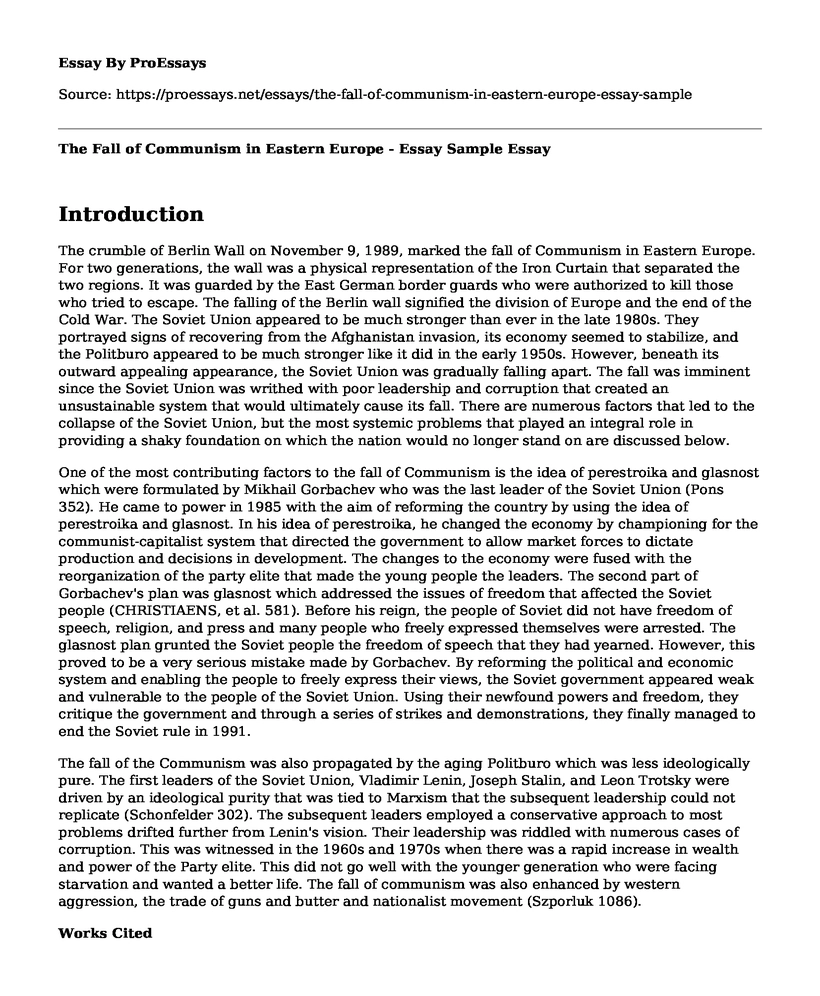Introduction
The crumble of Berlin Wall on November 9, 1989, marked the fall of Communism in Eastern Europe. For two generations, the wall was a physical representation of the Iron Curtain that separated the two regions. It was guarded by the East German border guards who were authorized to kill those who tried to escape. The falling of the Berlin wall signified the division of Europe and the end of the Cold War. The Soviet Union appeared to be much stronger than ever in the late 1980s. They portrayed signs of recovering from the Afghanistan invasion, its economy seemed to stabilize, and the Politburo appeared to be much stronger like it did in the early 1950s. However, beneath its outward appealing appearance, the Soviet Union was gradually falling apart. The fall was imminent since the Soviet Union was writhed with poor leadership and corruption that created an unsustainable system that would ultimately cause its fall. There are numerous factors that led to the collapse of the Soviet Union, but the most systemic problems that played an integral role in providing a shaky foundation on which the nation would no longer stand on are discussed below.
One of the most contributing factors to the fall of Communism is the idea of perestroika and glasnost which were formulated by Mikhail Gorbachev who was the last leader of the Soviet Union (Pons 352). He came to power in 1985 with the aim of reforming the country by using the idea of perestroika and glasnost. In his idea of perestroika, he changed the economy by championing for the communist-capitalist system that directed the government to allow market forces to dictate production and decisions in development. The changes to the economy were fused with the reorganization of the party elite that made the young people the leaders. The second part of Gorbachev's plan was glasnost which addressed the issues of freedom that affected the Soviet people (CHRISTIAENS, et al. 581). Before his reign, the people of Soviet did not have freedom of speech, religion, and press and many people who freely expressed themselves were arrested. The glasnost plan grunted the Soviet people the freedom of speech that they had yearned. However, this proved to be a very serious mistake made by Gorbachev. By reforming the political and economic system and enabling the people to freely express their views, the Soviet government appeared weak and vulnerable to the people of the Soviet Union. Using their newfound powers and freedom, they critique the government and through a series of strikes and demonstrations, they finally managed to end the Soviet rule in 1991.
The fall of the Communism was also propagated by the aging Politburo which was less ideologically pure. The first leaders of the Soviet Union, Vladimir Lenin, Joseph Stalin, and Leon Trotsky were driven by an ideological purity that was tied to Marxism that the subsequent leadership could not replicate (Schonfelder 302). The subsequent leaders employed a conservative approach to most problems drifted further from Lenin's vision. Their leadership was riddled with numerous cases of corruption. This was witnessed in the 1960s and 1970s when there was a rapid increase in wealth and power of the Party elite. This did not go well with the younger generation who were facing starvation and wanted a better life. The fall of communism was also enhanced by western aggression, the trade of guns and butter and nationalist movement (Szporluk 1086).
Works Cited
CHRISTIAENS, KIM, et al. "Entangled Transitions: Eastern and Southern European Convergence or Alternative Europes? The 1960s-2000s." Contemporary European History, vol. 26, no. 04, 2017, pp. 577-599.
PONS, SILVIO. "Western Communists, Mikhail Gorbachev, and the 1989 Revolutions." Contemporary European History, vol. 18, no. 03, 2009, p. 349.
Schonfelder, Bruno. "The evolution of law under communism and post-communism: a system-theory analysis in the spirit of Luhmann." Financial theory and practice 40.3 (2016): 293-318.
Szporluk, Roman. "Nationalism in Eastern Europe. Causes and Consequences of the National Revivals and Conflicts in Late-Twentieth-Century Eastern Europe." Europe-Asia Studies 50.6 (1998): 1086.
Cite this page
The Fall of Communism in Eastern Europe - Essay Sample. (2022, Dec 12). Retrieved from https://proessays.net/essays/the-fall-of-communism-in-eastern-europe-essay-sample
If you are the original author of this essay and no longer wish to have it published on the ProEssays website, please click below to request its removal:
- Meth Epidemic
- Thirteen Colonies That Form a Transcontinental Nation Essay
- Essay Sample on US Influence in Venezuela: Oil-Rich State, Internal Struggles & More
- Canada: An Education Superpower - Essay Sample
- Extremist Parties: Too Far or Part of Democracy? - Essay Sample
- Essay Example on Gov't Bailout of Troubled Companies: Pros, Cons, & Big Q's
- Essay Example on Risky Ventures: Ignoring the Consequences of Bureaucracy







